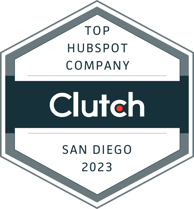How to Identify Revenue Bottlenecks in your Organization
by Joseph Freeman | Updated Dec 20, 2023
Do you know how to identify revenue bottlenecks in your organization?
The best way is to:
- Properly define your buyer's lifecycle stages with strict criteria
- Build rules and automation in your CRM to govern the changes based on your definition criteria
- Use a lifecycle funnel report to immediately spot where leads are getting stuck on their way to buying
When you do that, you go from seeing all your contacts incorrectly bunched up at the top of the funnel as subscribers and basic leads, like this...👇

...to an accurate depiction of how far your prospect has journeyed toward spending money with you, like this...👇

In this example, we can clearly see that prospects are getting stuck at the lead level. To unlock more MQLs here, we need to nurture them.
That alone gives your sales and marketing team a lot of clarity on where to focus this quarter's efforts.
To get started down the path of this kind of clarity, here's what you do...
STEP 1: Properly define your buyer's lifecycle stages with strict criteria.
I've worked with 100s of organizations and watched them struggle to align on definitions. With very few exceptions, these are the definitions that work best:
- Subscriber - Anyone who fills out a form to receive more info from you.
- Lead - Anyone who meets your basic demographic criteria.
- Marketing Qualified Lead (MQL- A Lead (that part is important) that has also shown buying intent by implicitly or explicitly "raising their hand to talk." We're gonna go way deeper on this next week.
- Sales Qualified Lead (SQL) - An MQL that a salesperson has actually corresponded with (phone, email, chat, text, whatever). This is where ALMOST EVERYONE trips up. Do not set hand-raisers as SQLs unless you've talked to them. More on this below.
- Opportunity - This is an SQL who has requested a quote. Please stop opening up "Deals" and "Opportunities" in your CRM prematurely. Wait till there's an actual conversation about money happening. Otherwise, you wreak havoc on lifecycle reporting and make your conversion rates abysmal.
- Customer - Someone who's bought from you.
- Evangelist- This is one of the most powerful yet underutilized of all the lifecycle stages. It's a customer who has proven they are a brand advocate by giving you a testimonial, a review, a backlink, or simply continuing to buy repeatedly. These people are your quickest channel for unlocking new revenue through referrals.
MQL vs. SQL
Marketing and sales teams muddy the waters between these two ALL THE TIME.
The difference between an MQL and SQL?
- An MQL has taken action indicating they'd like to talk to sales, but nobody has talked to them yet to confirm buying ability.
- An SQL is someone sales has talked to and whom they did NOT DISQUALIFY.
Period.
An SQL may not be ready to buy right now (if they were, they'd quickly move to "Opportunity"), but if the salesperson has confirmed buying potential, it should be marked as a sales-qualified lead.
IMPORTANT! There should be no exceptions and no fighting about where a contact should land in your CRM. Without being legalistic about these definitions, there is no way to trust your data. And if you can't trust your data...
...don't even bother building funnel and attribution reports.








